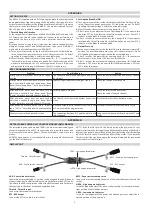
THRUSH AIRCRAFT INC – MODEL S2R R1340
AIRCRAFT MAINTENANCE MANUAL
5-4
Effective: 01/01/08
G. Use explosion-proof electric lights or
flashlights.
H.
Wear cotton clothing to avoid
possible static electricity discharge.
I. Service, defuel, and refuel aircraft as
outlined in Section 2.
J. Do not remove components from the
fuel system until replacement
components or covers are available
for exposed openings.
K. Always replace O-rings, seals, etc.
when re-installing fuel system
components.
FUEL SUB-SYSTEMS AND
COMPONENTS
FUEL TANK VENT SYSTEM
Ref. Figure 5-2
The fuel tanks are vented to a common
manifold. Tank vent tubes extend from
the wing root to the upper forward
outboard corner of each tank. The tubes
are attached to the vent manifold by
hoses.
The vent manifold is a single unit
composed of five aluminum tubes
welded together. The main cross tube is
a ½” tube. A ½” anti-siphon loop
attaches the main cross tube to the ½”
ram-air tube, which extends to the left
side only. Two ¼” tubes extend from
either side of the loop just above the
main cross tubes.
A ½” ram air inlet tube protrudes from the
left shin skin, below the wing, with the
opening forward. A hose connects the
ram air inlet to the ram air tube of the
manifold. The ends of the manifold main
cross tube are connected to the
respective tank vent tubes by hoses.
The two ¼” tubes are connected by
hoses to tee fittings screwed into bosses
on the inboard fuel tank ribs. The third
outlets of the tees are connected by
hoses to drain valves on the shin skins
below the wings.
The fuel vent manifold is installed
forward of the hopper, above and
forward of the wing spar. This position
puts the anti-siphon loop above the tank
vent tube ends in any ground attitude,
ensuring no fuel loss through the vent
system.
Before the first flight of the
day, ensure that the ram air
inlet is clear. Blockage,
such as by a “dirt dobber”,
could cause fuel starvation.
FUEL QUANTITY INDICATOR
Ref. Figure 5-3
A single fuel quantity indicator is installed
in the left instrument panel. This
indicator serves either the left or right fuel
tank by operation of a fuel tank-selector
switch adjacent to the indicator. The
indicator responds to the current flowing
through the fuel quantity transmitter by
positioning the needle proportionately.
The instrument face is marked in
increments from empty to full. Figure 5-1
shows the amount of fuel in the tank at
several pointer positions. Refer to
Section 8 for additional information.
FUEL QUANTITY TRANSMITTER
The fuel quantity transmitters are
installed in the inboard aft corner of the
wing fuel tanks. Access to the
transmitter is gained by removing the
inboard aft top cover plate. The
transmitters have a multi-coil resistor
and a contactor that is moved along the
resistance coil by the float arm. The
resistance thus varies in proportion to
the float arm position. The varying
resistance results in varying current flow
through the indicating circuit. As the
current flow varies the needle on the
fuel quantity indicator moves
proportionately to indicate the fuel level
in that tank.
CAUTION
















































